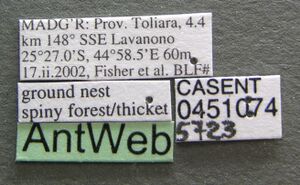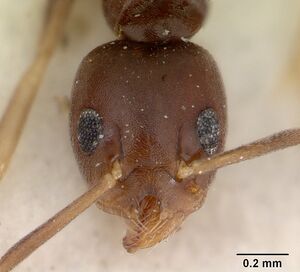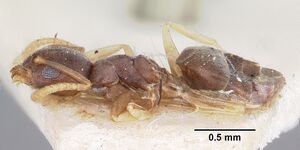Technomyrmex voeltzkowi
| Technomyrmex voeltzkowi | |
|---|---|

| |
| Scientific classification | |
| Kingdom: | Animalia |
| Phylum: | Arthropoda |
| Class: | Insecta |
| Order: | Hymenoptera |
| Family: | Formicidae |
| Subfamily: | Dolichoderinae |
| Genus: | Technomyrmex |
| Species: | T. voeltzkowi |
| Binomial name | |
| Technomyrmex voeltzkowi (Forel, 1907) | |
| Synonyms | |
| |
The species appears to be wholly terrestrial as samples have only been recorded from ground nests and from under rocks. Individual workers have been collected in pitfall traps and in sifted litter from dry forests. (Bolton 2007)
Identification
Bolton (2007) - A member of the Technomyrmex textor group. For the present all samples that answer this description are being retained as a single species, though I suspect that a close complex of sibling forms may eventually be analysed. Most of the material examined is represented only by individuals or short series of workers, but these are confusing. In some series all appear to be roughly the same size but in others the workers are distinctly polymorphic. Colour is very variable but does not appear linked to any other character that can be isolated. Thus, for the present, any specimen that fits the characters in the key and matches the description is referred to voeltzkowi.
Keys including this Species
Distribution
Latitudinal Distribution Pattern
Latitudinal Range: 0.6° to -29.331105°.
| North Temperate |
North Subtropical |
Tropical | South Subtropical |
South Temperate |
- Source: AntMaps
Distribution based on Regional Taxon Lists
Afrotropical Region: Botswana, Comoros, Kenya (type locality), Mozambique, South Africa, United Republic of Tanzania, Zimbabwe.
Malagasy Region: Madagascar.
Distribution based on AntMaps
Distribution based on AntWeb specimens
Check data from AntWeb
Countries Occupied
| Number of countries occupied by this species based on AntWiki Regional Taxon Lists. In general, fewer countries occupied indicates a narrower range, while more countries indicates a more widespread species. |

|
Estimated Abundance
| Relative abundance based on number of AntMaps records per species (this species within the purple bar). Fewer records (to the left) indicates a less abundant/encountered species while more records (to the right) indicates more abundant/encountered species. |

|
Biology
Castes
Worker
Images from AntWeb
   
| |
| Worker. Specimen code casent0451074. Photographer April Nobile, uploaded by California Academy of Sciences. | Owned by CAS, San Francisco, CA, USA. |
   
| |
| Worker. Specimen code casent0146743. Photographer Erin Prado, uploaded by California Academy of Sciences. | Owned by CAS, San Francisco, CA, USA. |
   
| |
| Type of Tapinoma voeltzkowi. Worker. Specimen code casent0104644. Photographer April Nobile, uploaded by California Academy of Sciences. | Owned by ZMHB, Berlin, Germany. |
    
| |
| Worker. Specimen code sam-hym-c004817. Photographer April Nobile, uploaded by California Academy of Sciences. | Owned by SAMC, Cape Town, South Africa. |
  
| |
| Excluded from type series by Bolton, 2007: 41. Worker. Specimen code casent0104645. Photographer April Nobile, uploaded by California Academy of Sciences. | Owned by ZMHB, Berlin, Germany. |
Nomenclature
The following information is derived from Barry Bolton's Online Catalogue of the Ants of the World.
- voeltzkowi. Tapinoma voeltzkowi Forel, 1907g: 84 (w.m.) KENYA. Combination in Technomyrmex: Shattuck, 1992c: 161. Senior synonym of rhodesiae: Bolton, 2007a: 41.
- rhodesiae. Tapinoma voeltzkowi var. rhodesiae Forel, 1913a: 139 (w.) ZIMBABWE. Combination in Technomyrmex: Shattuck, 1992c: 161. Junior synonym of voeltzkowi: Bolton, 2007a: 41.
Unless otherwise noted the text for the remainder of this section is reported from the publication that includes the original description.
Description
Worker
Bolton (2007) - TL 2.7 - 3.7, HL 0.66 - 0.92, HW 0.54 - 0.87, SL 0.63 - 0.80, PW 0.36 - 0.54, WL 0.82 - 1.12 (15 measured). Indices: CI 83 95, SI 92 - 116, 0126-31 EPI 80 - 100, DTI 120 - 140.
Dorsum of head behind clypeus entirely lacks setae. Anterior clipeal margin with a long, narrow, U-shaped median incision that is at least as long as wide; inner margin of incision meets anterior clypeal margin in a distinct angle at each side. Posterior margin of head in full-face view indented medially to broadly emarginate; depth of emargination usually increases with overall size but in some large workers extent of emargination is still small. Sides of head convex, more strongly so in larger workers than in smaller. Outer margins of eyes conspicuously fail to break the outline of the sides. Allometric variation present: as worker size increases CI increases and SI decreases; the largest workers have the broadest heads and shortest scapes. Dorsum of mesosoma and declivity of propodeum entirely lack setae. Mesonotal dorsum in profile more steeply sloped in its posterior half than anteriorly; metanotal groove weakly impressed. Gastral tergites 1 - 3 without setae; fourth gastral tergite with 1 - 2 pairs of setae present. Head, mesosoma, petiole and gaster light brown to blackish brown, sometimes the gaster a little darker than the mesosoma. Coxae, tibiae and tarsi lighter than mesosoma; femora usually darker than tibiae and tarsi.
Type Material
Bolton (2007) - LECTOTYPE worker (by present designation), Kenya; Malindi (Voeltzkow) (Berlin Museum für Naturkunde der Humboldt-Universität, see note).
T. voeltzkowi was described from two workers which on analysis are seen to belong to different species. The first, designated as lectotype above, matches the original description, especially as regards the obvious clypeal incision and lack of setae. The second, from W. Pemba [probably now Pemba Prov., Tanzanial, Fundu 1. (Voeltzkow) does not match the original description. This specimen is a worker of Technomyrmex pallipes, and is hereby excluded from the type-series and from further consideration of voeltzkowi.
References
- Bolton, B. 2007. Taxonomy of the dolichoderine ant genus Technomyrmex Mayr (Hymenoptera: Formicidae) based on the worker caste. Contributions of the American Entomological Institute. 35(1):1-149.
- Forel, A. 1907i. Ameisen von Madagaskar, den Comoren und Ostafrika. Wiss. Ergeb. Reise Ostafr. 2: 75-92 (page 84, worker, male described)
- Shattuck, S. O. 1992c. Generic revision of the ant subfamily Dolichoderinae (Hymenoptera: Formicidae). Sociobiology 21: 1-181 (page 161, Combination in Technomyrmex)
References based on Global Ant Biodiversity Informatics
- Bolton B. 2007. Taxonomy of the dolichoderine ant genus Technomyrmex Mayr (Hymenoptera: Formicidae) based on the worker caste. Contributions of the American Entomological Institute 35(1): 1-150.
- Bolton, B. "Taxonomy of the dolichoderine ant genus Technomyrmex Mayr (Hymenoptera: Formicidae) based on the worker caste." Contributions of the American Entomological Institute 35, no. 1 (2007): 1-149.
- Emery C. 1913. Hymenoptera. Fam. Formicidae. Subfam. Dolichoderinae. Genera Insectorum 137: 1-50.
- Forel A. 1907. Ameisen von Madagaskar, den Comoren und Ostafrika. Wissenschaftliche Ergebnisse. Reise in Ostafrika 2: 75-92.
- Hita Garcia F., E. Wiesel, G. Fischer. 2013. The ants of Kenya (Hymenoptera: Formicidae)faunal overview, first species checklist, bibliography, accounts for all genera, and discussion on taxonomy and zoogeography. Journal of East African Natural History 101: 127-222.
- Hita Garcia, F., G. Fischer, M.K. Peters, R.R. Snelling and H.W. Wagele. 2009. A preliminary checklist of the ants (Hymenoptera: Formicidae) of Kakamega Forest (Kenya). Journal of East African Natural HIstory 98(2): 147-165.
- IZIKO South Africa Museum Collection
- Prins A. J. 1964. Revised list of the ants collected in the Kruger National Park. Koedoe 7: 77-93.
- Shattuck S. O. 1994. Taxonomic catalog of the ant subfamilies Aneuretinae and Dolichoderinae (Hymenoptera: Formicidae). University of California Publications in Entomology 112: i-xix, 1-241.
- Wheeler W. M. 1922. Ants of the American Museum Congo expedition. A contribution to the myrmecology of Africa. VIII. A synonymic list of the ants of the Ethiopian region. Bulletin of the American Museum of Natural History 45: 711-1004

